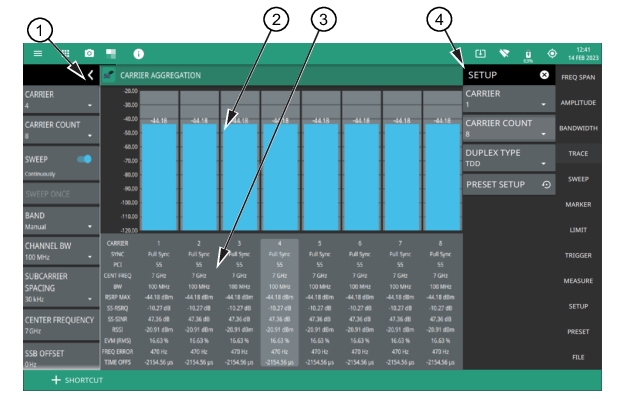 |
1. 5GNR Analyzer Status Panel: Each measurement features a unique status panel that displays settings and information relevant to the current measurement and view settings. This panel provides quick access to the measurement frequency, subcarrier spacing, channel bandwidth, and band configuration. See Status Panel (5GNR Carrier Aggregation). 2. Signal Level: This area shows a bar graph of the RSRP of the SSB beam with the lowest detected EVM. 3. Summary Display: Shows data for each numbered component carrier. The highlighted summary display area is the component carrier data that can be edited, and this area can be touched to select that component carrier for editing. A rotating magenta circle indicates which carrier is currently being measured. • Sync status indicating primary synchronization signal (PSS) full synchronization or PSS failure. • Physical Cell ID (PCI) identifying information sent by the transmitter in the sync signal. • Center frequency of the measurement channel. • Channel bandwidth (BW) sets the bandwidth of the component carrier. • Reference Signal Received Power (RSRP) max power is displayed in dBm. The reference signal is used for downlink channel estimation. • SS-RSRP indicates the average power received from a single Reference signal or the level of the received signal from the base station. • SS-RSRQ indicates the quality of the received signal. • SS-SINR indicates the ratio of the signal level to the noise level. Higher the value, the better is the signal quality. • EVM (RMS) shows the percentage value of all the error vectors between the reconstructed ideal signals and the received signals divided by the RMS value of the ideal signals. • Frequency error is the difference between the measured carrier frequency and the specified carrier frequency. This measurement is only as accurate as the frequency reference that is used and is typically only useful with a good external frequency reference or GNSS (GPS). • Time offset shows the time difference between the measured start of the 5GNR frame and the 10 ms frame trigger, which is automatically synchronized to GNSS (GPS) when the instrument has GNSS (GPS) lock. 4. SETUP Menu: The component carrier settings are configured in the SETUP menu. See SETUP Menu (5GNR Carrier Aggregation). |
